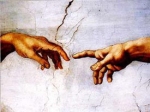Verse: Nehemiah 8:18 They kept the feast seven days, and on the eighth day there was a solemn
assembly, according to the rule. ESV
Shemini Atzeret
The seventh day of the Feast of Tabernacles is known as “Hoshana Rabba” or the “Great Salvation”. It
was on this day that Jesus interrupted the water ceremony in the morning and declared that He was the
Living Water. He openly declared that through Him, the gift of the indwelling Holy Spirit would be
poured out on anyone who believed (trusted and relied) on Him as the Messiah.
The day following Hoshanna Rabba is called Shemeni Atzeret (the eighth day assembly). It originates
from:
Numbers 29:35-36
"On the eighth day you shall have a solemn assembly. You shall not do any ordinary work, ESV
Shemini Atzeret is actually a separate gathering from the seven-day Feast of Tabernacles even though it
is connected to the seven-day feast.
Leviticus 23:41-43
You shall celebrate it as a feast to the Lord for seven days in the year. It is a statute forever
throughout your generations; you shall celebrate it in the seventh month. You shall dwell in
booths for seven days. All native Israelites shall dwell in booths, that your generations may
know that I made the people of Israel dwell in booths when I brought them out of the land of
Egypt: I am the Lord your God." ESV
It is interesting and somewhat important to note that only the first day of the Feast of Tabernacles and
the Eighth Day are set apart as “solemn assemblies” on the calendar. The other six days between them
are days for joy, fellowship, and celebration. Everyone is to dwell in sukkahs during those days, but they
do not carry the weight of being set apart as specific Sabbath days.
Sukkot (Feast of Tabernacles) is for everyone. The Shemini Atzeret (the Eighth Day Assembly) is for His
special people. The Eighth Day is not as much of a public celebration of the Lord as it is a private, more
intimate fellowship with a close friend.
A well-known Torah commentator named Rashi (1040 AD – 1105 AD) characterized Sukkot as the very
public celebration and Shemini Atzeret as the private dinner held afterwards for God’s closest special
friends. The Jews have always considered themselves friends of God and this notion is wel- founded.
Today, as co-heirs of the promises of Abraham (who was God’s friend, see 2 Chronicles 20:7; Isaiah 41:8;
James 2:23), we can consider ourselves special guests to the convocation held on the Eighth Day every
year in the seventh month. Who would want to ignore or miss such a special invitation?
Eternity
Seven is the number of divine completeness (See more about that on this page). Eight is the number of
“new beginnings” and “a new order”. It can also be a symbol for “the age to come” or “eternity”.
There is a Hebrew word transliterated as “owlam” it is Strong’s number OT: 5769 and it is defined as follows:
`owlam (o-lawm'); or `olam (o-lawm'); from OT:5956; properly, concealed, i.e. the vanishing
point; generally, time out of mind (past or future), i.e. (practically) eternity; frequentatively,
adverbial (especially with prepositional prefix) always:
KJV translates the word as - alway (-s), ancient (time), any more, continuance, eternal, (for, [n-
]) ever (-lasting, -more, of old), lasting, long (time), (of) old (time), perpetual, at any time,
(beginning of the) world (+without end). Compare OT:5331, OT:5703.
This word appears in the Old Testament 438 times and it is often, but not always used in the Hebrew
expression “from everlasting to everlasting”. This expression means from “eternity to eternity”. God
dwells in eternity (owlam), but we presently dwell in time. (see Psalm 41:13, Psalm 90:1-2, Psalm
103:13-18, Psalm 106:47-107:1)
The Shemini Atzeret seems to me to be a picture of YHWH’s invitation and promise to bring us into the
“eternity” where He is always living. Some would call it “heaven” and I am not arguing about that, but it
is definitely a “new beginning” and a “new order”. This is further emphasized through the patterns of
the feasts in that none of the requirements for living in temporary booths (sukkahs) are carried through
to the Eighth Day convocation. This represents our dwelling in peace and intimate fellowship forever, in
eternity as God’s “special people”.
Hebrews 7:23-25
The former priests (speaking of the Levites and the sons of Aaron) were many in number,
because they were prevented by death from continuing in office, but he (Jesus, our Messiah)
holds his priesthood permanently, because he continues forever. Consequently, he is able to
save to the uttermost those who draw near to God through him, since he always lives to make intercession for them. ESV
1 Peter 2:9-10
But you are a chosen race, a royal priesthood, a holy nation, a people for his own possession,
that you may proclaim the excellencies of him who called you out of darkness into his marvelous
light. ESV
Simchat Torah
Simchat Torah (Joy of the Torah) is kept by Jews the day following the Shemini Atzeret (Eighth Day); it is
the ninth day from the beginning of the Feast of Tabernacles. Simchat Torah is not included in any of
the prescribed appointed times given in the Torah. It is a holiday celebration added into the Jewish calendar during the 10th century.
Every week during the Jewish calendar, there are prescribed Torah portions read and taught in
synagogues. Each year the whole Torah is read and studied, the Torah cycle repeats every year. On the
Simchat Torah, the reading cycle connects the last reading in Deuteronomy to the first reading in
Genesis and thus celebrates the never ending Word of God.
The most interesting part of this day to me is not the readings themselves, but the tradition of dancing
with the Torah Scrolls. On this particular day, the Torah scrolls are carefully removed from the
“tabernacle” in which they are kept in the synagogue and the teachers of Torah dance with the actual
scrolls. Everyone in the room joins in the celebration with traditional songs creating a joyful atmosphere.
When we consider that Jesus is the Torah made flesh (John 1:1-5), this tradition resembles the
conclusion of a wedding when the bride and the groom dance together in celebration of their completed
vows at the very beginning of their eternal covenant marriage (Ephesians 5:25-32).
For more details on the traditions of Simchat Torah see:
http://www.hebrew4christians.com/Holidays/Fall_Holidays/Simchat_Torah/simchat_torah.html
or here:
https://www.hebrew4christians.com/Holidays/Fall_Holidays/Simchat_Torah/simchat_torah.html#loaded





Terms & Conditions
Subscribe
Report
My comments